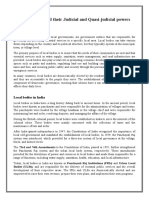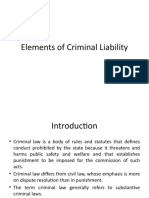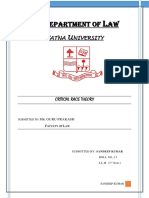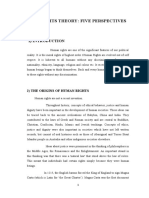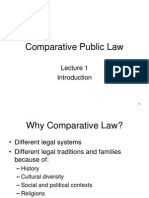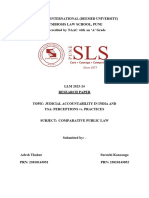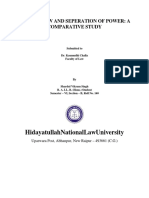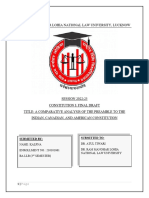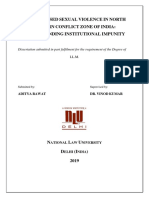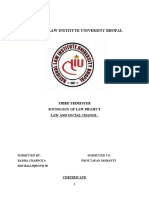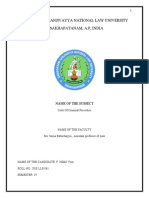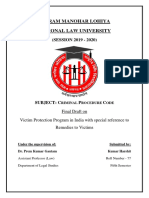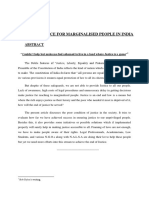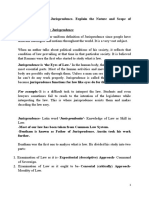Concept of Global Law and
Justice
� I. What is global law?
II. Concept of global justice
III. Theories and perspectives of global justice
(i) Critical legal studies
(ii) Post modernist jurisprudence
(iii) Feminist jurisprudence
IV. Challenges to global justice
(i) Global poverty
(ii) Armed conflict and Crimes against humanity
(iii) Environmental catastrophe & sustainable
development and health
(iv) Oppressive policies
�What is Global Law?
• Globalization is changing not only modern socio-
economic and politico-cultural systems but also
the law, decision-making processes, enforcement
strategies, and the interrelations between multiple
normative systems and sub-systems.
• It appears that global law is in an embryonic
phase.
• It is growing as the law of a common humanity
bringing with it the emergence of an
organizational model of the world’s society based
on the gradual integration of various systems of
organization (legal, social, economic, etc.) at
different aggregation levels, local to worldwide.
�•The question has also arisen as to whether a
notion of global law is emerging for the benefit
of multinational economic players or the
international community at large.
•For instance, the growing globalisation requires
a harmonisation and unification of the rules of
law governing world trade.
•As diverging national laws create significant
obstacles to cross-border transactions, the
efforts toward the harmonization of national
legal principles through the production of a
"set of global substantive rules" are highly
significant.
�•Nevertheless, analysis of the concept of global
law is per se controversial.
•It appears that the concept of global law is
rather lacking the precision and formality one
would normally expect from a classical legal
system.
•Again, the question arises as to the access of
information on rules and contents and systems
sanctioning the violations of global law.
� Notion of Global Law:
•The notion of global law entertains some
relations at least with the fields of international
public law, international private law,
comparative law, international trade law and,
the lex mercatoria.
(1) Global Law and International Public Law:
•While international public law is certainly quite
relevant to global law, the fact that it deals
mainly with relations between governments
makes it too narrow to cover the full regulatory
needs of a global economy and its multitude of
private economic players.
�•(2) Global Law and International Private Law:
•While the concept and extent of international
private law may vary from one legal system to
another, generally it covers both the areas of
conflict of laws and conflict of jurisdictions.
•However, since global law is supposed to find
its roots in the emergence of internationally
recognized legal rules and principles of interest
for the world economy at large, its basis is very
international compared to international private
law and its ambition is to cover much more
ground than just choice of law or competent
court selection.
� (3) Global Law and Comparative Law:
•As its name indicates, comparative law is about
comparing, and the comparison is generally
between i) national laws of different countries
or ii) groups of legal systems.
•Since the essence of comparative law is to
compare national laws, it can only represent
one aspect of the notion of global law.
�(4) Global Law and International Economic Law:
•The broad field of international economic law
certainly covers many areas that global law is
meant to cover.
•It can be defined as the collection of norms
regulating the organization of international
economic relations, mainly at macroeconomic
level.
•However, the multidisciplinary nature of the
notion of global law requires extending the
frontier of global law beyond mere trade and
investment relations.
� (5) Global Law and the Lex Mercatoria:
• The lex mercatoria can be defined as a collection
of transnational legal principles, which derive from
international contract practice and are especially
suited to meet the needs of international
commercial transactions.
• The existence of the lex mercatoria as the
expression of global economic reality.
• However, the notion and scope of global law is
much wider than the lex mercatoria, since global
law is not meant to be restricted to the
development of legal principles exclusively
applicable to international commercial contracts.
� Defining Global Law:
•It can be said that global law primarily is a
multicultural, multinational, and
multidisciplinary legal phenomenon, which has
not yet reached the maturity and formality of a
structured legal system.
•On the other hand, it can be defined as a
multicultural, multinational, and
multidisciplinary legal phenomenon finding its
roots in international and comparative law and
emerging through the international legal practice
that was prompted by the globalization of the
world economy.
�•Global law is broader than legal fields such as
comparative law, international private law, or
international public law. All these legal fields
are relevant to the process of globalization of
the world economy, but are too narrow to
reflect its overall dimension.
•According to Joseph Weiler, “Global Law School
is not only, or even mostly, about
‘International’ or ‘Globalization’ with a capital
‘I’ or ‘G’ but is a reflection of the
internationalization and globalization of all
dimensions of law, be they corporate or
environmental”.
� The Creation of Global Law
•The notion of global law is clearly in its infancy,
and we are still very far from an officially
recognized and codified legal field.
•However, still there is hope for more formalism
and more precision in the development of
global law and in the definition of its
parameters.
•Global law is made (if it can be) for and by
global players.
�•The emergence of what is prudently qualified
as a legal phenomenon is the result of actions
undertaken and efforts deployed by a
multitude of institutions and individuals
impacting, directly or indirectly, the
international scene.
•The United Nations
•The European Union
•The International Chamber of Commerce
•International Arbitration Centers
•International Trade Associations
� Concept of Global Justice
•What is Justice?
•What is the Concept of Global Justice?
•Whom is Global Justice for?
•What goals can or should Global Justice serve?
•Justice as peace, justice as doing no harm,
justice as equality, justice as reward, justice as
welfare (social justice), justice as righteousness
(religious-mystical justice), justice as individual
agency, utilitarianist justice supplementary to
private ethics, etc.
•From whose perspective should Global Justice
be viewed?
�What Is, Is, Therefore, Just: Undisputed Reality Of
Financial Globalization
• Among the many forms and manifestations of
globalization, that of the capital markets has been the
most powerful in its overall effect and is driving with
increasing force a global demolition of national and
local frontiers.
• Society is being transformed into a “market society”
on a global scale, and political power based on
financial power results in new global forms of social
exclusion.
• Financial globalization is the main driving force behind
all other forms of globalization, such as movement of
people and goods (including immigration),
communication and media, cultural exchange and
imitation, and so on.
�•The relentless drive for financial globalization,
which is the reality on which any discourse on
law, justice, and fairness must be based,
presupposes a principled respect of private
property rights and the primacy of economic
value over any other asset assessment.
•(1) The Property Issue: Justice as Entitlement:
Robert Nozick argues that welfarism, and its
restrictions and claims on private wealth,
violates the important principle that human
beings are ends in themselves and cannot be
treated as means to an end, however
charitable and desirable that end can be to (the
majority of) others.
�• He also argues that personal rights cannot be
violated in pursuit of any social goal, without
consent. Such rights include the right to legitimately
acquired property.
• A fundamental principle of justice is entitlement to
just holdings. Such entitlement comes only from an
original acquisition, exchange, or gift, and cannot be
violated for the pursuit of any social goal.
• Contrary to Rawls’s contractarian vision of social
justice that allows the violation of property rights to
the extent that they result in privilege and inequality
for the benefit of the least advantaged members of
the community, Nozick argues that justly acquired
property (wealth) can only be given away
voluntarily.
�•Private property is excluded and access is only
allowed at a (financial or other) price.
•Is, and to what extent how is, such exclusion,
through an increasingly global enforcement of
private property rights, justifiable? Are there
any objects (goods) or portions of objects that
should, in the interests of justice, be retained
or extra-commercium? How can this be done in
practice in a way that is compatible with the
realities of globalization?
•Could one contemplate global public goods or
global social goods?
�•(2) The Poverty Issue: Instrumental Justice:
•As Thomas Nagel observes, “The gruesome
facts of inequality in the world economy are
familiar. Roughly 20 percent of the world's
population live on less than a dollar a day, and
more than 45 percent live on less than two
dollars a day, whereas the 15 percent who live
in the high-income economies have an average
per capita income of seventy-five dollars a
day”.
�•Thomas Pogge has argued that severe poverty
and mass violence are violations of basic
human rights, and that the international legal
order is in this respect not merely imperfect
but fundamentally unjust. He calls for a
minimum standard of fairness to defend
against severe poverty and mass violence on a
global scale.
�(3) The Human Rights Issue: Principled Justice
How has the globalization process affected the
issue of defining human good? If financial
globalization is a single-track phenomenon,
defining human good remains a multi-faceted
one, with often extreme local variations of self-
determination and righteousness values. On
what grounds is it justifiable to ignore such
variations, and, if it is, on what basis can any
concepts of a global definition of human good
be founded?
�Concept of Justice in the Era of Transition
•Global Not Domestic Justice?: The fates of all
societies have today come to be linked in ways
that no longer allow any state to postulate and
implement what may be termed a domestic theory
of justice.
• The choice in many ways is now reduced to either
global justice or domestic injustice of one kind or
another.
• The idea of an emerging Global State is important
or the lack of some form of global sovereignty is
said to preclude the idea of global justice.
�•There are three kinds of legitimate claims that
constitute the idea of global justice which can
help establish a global law of welfare in the
matrix of international human rights law.
•These are claims for redistribution, claims for
recognition, and claims for representation.
•The claims for global distributive justice will be
difficult to realize unless the claims for
recognition and representation are addressed.
Misrecognition may eliminate the possibility of
realizing claims for redistribution, and
representation.
�•Claims for Recognition:
•The first principle with respect to claims for
recognition is that international instrument
must safeguard to use the expression of “the
other of otherness”.
•A second principle is that we must take all
human suffering equally seriously.
•A third principle should be that we must not
propose a settlement to others that we
ourselves would be unwilling to accept if the
situation were reversed.
�•Claims for Redistribution:
•The first principle is that third world peoples
must not be denied economic policy options
that the developed world has exercised or is
exercising.
•Second principle of redistributive justice would
call for establishing the practice of social audit
of international economic laws, in particular to
assess their impact on the global poor.
•The third principle is that humanitarian
assistance should be provided to all those in
need without discrimination and not be used
to advance non-humanitarian ends.
�• Claims for Representation:
• The first principle is the practice of some form of
direct global democracy symbolizing a global
political space that parallels the creation of a global
economic space.
• A second principle is to make procedural justice
central to the principle of international cooperation.
• Third principle is that in view of the growing role of
international institutions as building blocks of an
emerging Global State their responsibility in
international law be clearly defined.
• The fourth principle is that global populations
adversely affected by international laws and policies
must have a say in the institutions that prescribe
and enforce them.
�Perspectives of Global Justice: Post-Modernism
• The term postmodernism is used as a marker of a
cultural era identified as the period after modernism
or the postmodern era.
• Modernism, as an era, is defined as the period when
people came to terms with the Industrial Age and
explored innovative and non-traditional methods of
expression.
• If, therefore, postmodernism is defined as simply the
period when people are coming to terms with the
computer or information age as opposed to the
Industrial Age, such a broad definition of
postmodernism fails to capture the more radical and
complex meanings attached to the word by scholars
in the past forty years.
�• The term “postmodern” is used not just to refer to
an era but to a philosophical movement that has
profoundly affected the way scholars look at the law
and legal text in particular.
• The core of this movement is a rejection of
modernism.
• Modernism has been characterized as a period
when tradition and authority were rejected in favour
of reason and science.
• Modernists work to reduce meanings of ideas,
words and texts to an “essential core or single
truth.”
• Modernism assumes that the autonomous and
rational individual is solely responsible for finding
the truth and creating meaning from the world.
�•Modernists rejected tradition and authority in
favour of reason and science, but its views of
reason and science seek out only single
unifying theories of reason and science.
•Modernists believe truth is a concept that is
uncovered through progress.
•Whereas, postmodernists claim modernism is
too centralized and monolithic in its mindset.
•Post-modernists reject articulating a single
meaning or definition of truth or, in fact, any
modernist concept.
•Skepticism is applied to the very meaning of
words, even the word “postmodernism”.
�• Where modern thought emphasises direction,
order, coherence, stability, simplicity, control,
autonomy, and universality, post modern thought
emphasises fragmentation, diversity, discontinuity,
contingency, pragmatism, multiplicity, and
connections.
• In modern thought, ideas about equality, justice and
progress are closely bound up with ideas about
reason and knowledge in a one-size-fits-all system.
• Post-modernism is the passage from ‘solid’ (stable)
times to ‘liquid’ times.
• It is the end of traditional structures and
institutions, and the end of what is called ‘grand
narratives’–the big, one-size-fits-all stories of
modern thought.
�•Premodern jurisprudence was based on natural
law principles.
•Modern jurisprudence rejected these natural
law principles in favour of rational, scientific,
empirical and secular principles.
•The Restatement treatises are most
emblematic of legal modernism.
•Restatements derive supposedly objective,
neutral, and ordered rules of law from the
common law, and such a search for an orderly,
monolithic articulation of the law is thoroughly
modern.
� Critical Legal Studies
•While legal scientism and the restatements are
illustrative of modernism, scholars criticizing
these movements are not necessarily
postmodernists. Legal realists and scholars from
the critical legal studies (CLS) movement are
often very modernist in their philosophy.
•Legal realists used economics and other social
sciences as methods of study of the legal system.
•CLS scholars used Marxism and politics as the
“metanarrative” to explain the functioning of the
legal system and to work towards the progressive
improvement of the legal system.
�•While the foundations of the legal realist and
CLS movements are modernist, these
movements formed a bridge to postmodern
legal movements.
•These movements’ examination of the
connection between law and society sowed the
seeds of the postmodern legal movement.
Postmodern scholars rejected the idea that law
could be rendered coherent by a
comprehensive legal theory.
�• Feminist Jurisprudence:
• The term “discrimination against women” shall
mean any distinction, exclusion or restriction made
on the basis of sex which has the effect or purpose
of impairing or nullifying the recognition, enjoyment
or exercise by women, irrespective of their marital
status, on the basis of equality of men and women
of all human rights and fundamental freedoms.
• The principle of the equality of men and women in
the national constitutions or other appropriate
legislation needs to be incorporated.
• All appropriate measures, including legislation, to
modify or abolish existing laws, regulations, customs
and practices which constitute discrimination
against women must be taken.
�•Special measures must be directed at recognizing
and implementing equal rights in education and
vocational guidance and career advancement.
•The opportunity to represent their Governments
at the international level and to participate in the
work of international organizations must be
clearly made available and safeguarded for
women.
•Measures, including legislation, to suppress all
forms of traffic in women and exploitation of
women.
•The right to work as an inalienable right of all
human beings.
�• The right to equal remuneration, including
benefits, and to equal treatment in respect of
work of equal value, as well as equality of
treatment in the evaluation of the quality of work.
• The right to social security, particularly in cases of
retirement, unemployment, sickness, invalidity
and old age and other incapacity to work, as well
as the right to paid leave.
• Women must be accorded, in civil matters, legal
capacity identical to that of men and the same
opportunities to exercise that capacity.
• Measures to be taken to eliminate discrimination
against women in all matters relating to marriage
and family relations.
� Challenges to Global Justice
Poverty entails more than the lack of income
and productive resources to ensure sustainable
livelihoods. Its manifestations include hunger
and malnutrition, limited access to education
and other basic services, social discrimination
and exclusion, as well as the lack of participation
in decision-making.
More than 700 million live in extreme poverty—
less than $ 2.15 ($1.90) a day.
1 billion children worldwide are living in poverty.
�•In 2015, more than 736 million people lived
below the international poverty line.
•Around 10 per cent of the world population
(pre-pandemic - COVID-19) was living in
extreme poverty and struggling to fulfil the
most basic needs like health, education, and
access to water and sanitation, to name a few.
•There were 122 women aged 25 to 34 living in
poverty for every 100 men of the same age
group, and more than 160 million children
would be at risk of continuing to live in extreme
poverty by 2030.
�• Southern Asia and sub-Saharan Africa are
expected to see the largest increases in extreme
poverty, with an additional 32 million and 26
million people, respectively, living below the
international poverty line as a result of the
pandemic.
• The share of the world’s workers living in extreme
poverty fell by half over the last decade: from 14.3
per cent in 2010 to 7.1 per cent in 2019.
• Even before COVID-19, baseline projections
suggested that 6 per cent of the global population
would still be living in extreme poverty in 2030.
• The fallout from the pandemic threatens to push
over 70 million people into extreme poverty.
� Crucial Challenges in Poverty Reduction
•Both extreme and moderate poverty remain
primarily rural, with 78 percent of the world’s
poor living in rural areas and most dependent
on agriculture.
•Rural poverty has persisted where policies paid
insufficient attention to improving agricultural
productivity and rural infrastructure and failed
to provide rural populations with access to
social services and social protection.
�•Climate change and other environmental
threats, rapid population growth and migration
are putting disproportionate pressure on
livelihoods in rural areas where poverty is
already entrenched and people have the least
resilience.
•Employment opportunities need to be
generated, consistent with the decent work
agenda.
•As the vast majority of poor people live in
impoverished rural areas, the main focus must
be on building more productive, diversified and
resilient local rural economies with stronger
rural-urban economic linkages.
�•Reducing poverty requires ecological and
resource sustainability. Increased food
production will exacerbate land degradation,
greenhouse gas emissions and biodiversity loss
unless production methods and consumption
patterns become more sustainable.
•Diversification of employment into non-
agricultural activities will be essential to
accelerate both rural and urban poverty
reduction.
•Closing the gender gaps in education and access
to productive resources can substantially boost
women’s empowerment and incomes,
particularly in agriculture and rural areas.
�India’s Multidimensional Poverty Index (MPI)
According to NITI Aayog’s National
Multidimensional Poverty Index (MPI) [which
has three equally weighted dimensions – health,
education, and standard of living], India's
population living in multidimensional poverty was
14.96%. The rural areas of India
experienced multidimensional poverty of 19.28%.
In urban areas, the poverty rate was 5.27%.
According to the data from the World Bank, about
10% of the Indian population lives on less than
USD 2.15 a day, which is the international poverty
line for lower-middle income countries.
�Cusses behind multidimensional poverty in
India:
(i) lack of inclusive economic growth; (ii) sluggish
agricultural performance and poverty; (iii) non-
implementation of land reforms; (iv) rapid
population growth; (v) unemployment and
under-employment; (vi) slow growth of
employment opportunities in the organized
sector; and (vii) lack of access to basic services.













